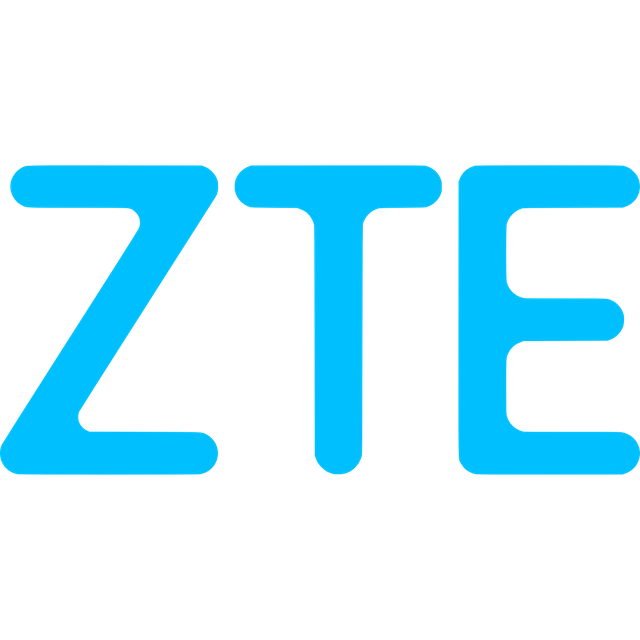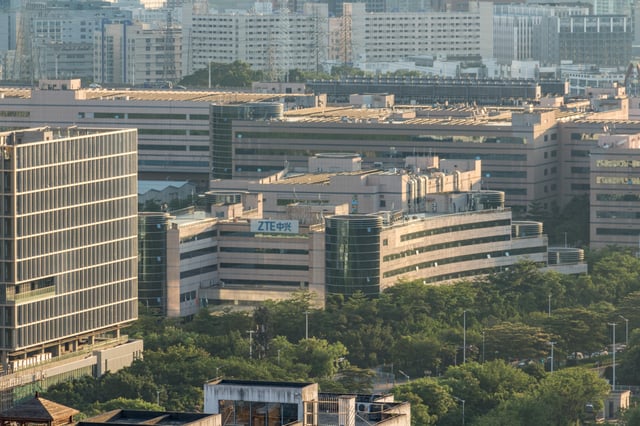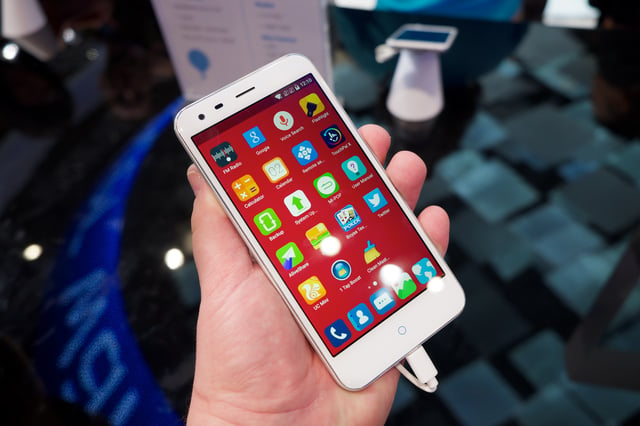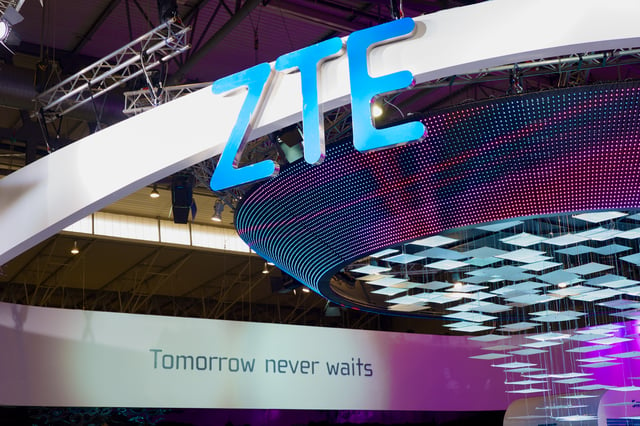ZTE

ZTE

 ZTE corporate campus in Shenzhen, Guangdong | |||||||||||
Formerly | Zhongxing Telecommunication Equipment Corporation | ||||||||||
|---|---|---|---|---|---|---|---|---|---|---|---|
Type | Public | ||||||||||
| Traded as | SZSE: 000063 [112] SEHK: 763 [113] | ||||||||||
| ISIN | CNE000000TK5 [114] CNE1000004Y2 [115] | ||||||||||
| Industry | Telecommunications equipment Networking equipment | ||||||||||
| Founded | 1985 (1985)(as Zhongxing Semiconductor Co., Ltd.) | ||||||||||
| Founder | Hou Weigui (Chinese:侯為貴; pinyin: *Hóu Wéiguì*) | ||||||||||
| Headquarters | 55 Hi-tech Road South Shenzhen, Guangdong, China 518057 | ||||||||||
Area served | Worldwide | ||||||||||
Key people | Yin Yimin (Chairman) Zhao Xianming (President and Executive Director)[1] | ||||||||||
| Products | Mobile phones, smartphones, tablet computers, hardware, software and services to telecommunications service providers and enterprises | ||||||||||
| Revenue | |||||||||||
Operating income | |||||||||||
Net income | |||||||||||
| Total assets | |||||||||||
| Total equity | |||||||||||
| Owner | Zhongxingxin (30.34%) | ||||||||||
Number of employees | 74,773 (2017) | ||||||||||
| Subsidiaries | Nubia Technology (49.9%) ZTEsoft Zonergy | ||||||||||
| Website | zte.com.cn [116] ztedevice.com [117] | ||||||||||
| Footnotes / references In consolidated financial statement;[1] shareholders' equity figure are excluding perpetual capital instrument | |||||||||||
| ZTE Corporation | |||||||||||
| Simplified Chinese | 中兴通讯股份有限公司 | ||||||||||
| Traditional Chinese | 中興通訊股份有限公司 | ||||||||||
| Literal meaning | China-Prosperity CommunicationsCompany Limited by Shares | ||||||||||
| |||||||||||
| Alternative Chinese name | |||||||||||
| Simplified Chinese | 中兴通讯 | ||||||||||
| Traditional Chinese | 中興通訊 | ||||||||||
| Literal meaning | China-Prosperity Communications | ||||||||||
| |||||||||||
| Second alternative Chinese name | |||||||||||
| Simplified Chinese | 中兴 | ||||||||||
| Traditional Chinese | 中興 | ||||||||||
| Literal meaning | China-Prosperity [or the word itself: resurgence] | ||||||||||
| |||||||||||
ZTE Corporation is a Chinese multinational telecommunications equipment and systems company headquartered in Shenzhen, Guangdong, China. It is one of China's leading telecom equipment manufacturers.[2]
ZTE operates in three business units: carrier networks (54%), terminals (29%) and telecommunication (17%), their core products being wireless, exchange, access, optical transmission, and data telecommunications gear; mobile phones; and telecommunications software.[3]
It also offers products that provide value-added services,[4] such as video on demand and streaming media.[5] ZTE primarily sold products under its own name, but it is also an OEM.[6] ZTE is one of the top five largest smartphone manufacturers in its home market.[7]
As with Huawei, the company has faced criticism in the United States over potential ties to the Chinese government that could enable surveillance. In 2017, ZTE was fined for illegally exporting U.S. technology to Iran and North Korea in violations of economic sanctions.[8] In April 2018, after the company failed to properly reprimand the employees involved, the U.S. Department of Commerce banned U.S. companies (semiconductors) from exporting to ZTE for seven years. The ban was lifted in July 2018 after ZTE replaced its senior management, and agreed to pay additional fines and establish an internal compliance team for 10 years.
 ZTE corporate campus in Shenzhen, Guangdong | |||||||||||
Formerly | Zhongxing Telecommunication Equipment Corporation | ||||||||||
|---|---|---|---|---|---|---|---|---|---|---|---|
Type | Public | ||||||||||
| Traded as | SZSE: 000063 [112] SEHK: 763 [113] | ||||||||||
| ISIN | CNE000000TK5 [114] CNE1000004Y2 [115] | ||||||||||
| Industry | Telecommunications equipment Networking equipment | ||||||||||
| Founded | 1985 (1985)(as Zhongxing Semiconductor Co., Ltd.) | ||||||||||
| Founder | Hou Weigui (Chinese:侯為貴; pinyin: *Hóu Wéiguì*) | ||||||||||
| Headquarters | 55 Hi-tech Road South Shenzhen, Guangdong, China 518057 | ||||||||||
Area served | Worldwide | ||||||||||
Key people | Yin Yimin (Chairman) Zhao Xianming (President and Executive Director)[1] | ||||||||||
| Products | Mobile phones, smartphones, tablet computers, hardware, software and services to telecommunications service providers and enterprises | ||||||||||
| Revenue | |||||||||||
Operating income | |||||||||||
Net income | |||||||||||
| Total assets | |||||||||||
| Total equity | |||||||||||
| Owner | Zhongxingxin (30.34%) | ||||||||||
Number of employees | 74,773 (2017) | ||||||||||
| Subsidiaries | Nubia Technology (49.9%) ZTEsoft Zonergy | ||||||||||
| Website | zte.com.cn [116] ztedevice.com [117] | ||||||||||
| Footnotes / references In consolidated financial statement;[1] shareholders' equity figure are excluding perpetual capital instrument | |||||||||||
| ZTE Corporation | |||||||||||
| Simplified Chinese | 中兴通讯股份有限公司 | ||||||||||
| Traditional Chinese | 中興通訊股份有限公司 | ||||||||||
| Literal meaning | China-Prosperity CommunicationsCompany Limited by Shares | ||||||||||
| |||||||||||
| Alternative Chinese name | |||||||||||
| Simplified Chinese | 中兴通讯 | ||||||||||
| Traditional Chinese | 中興通訊 | ||||||||||
| Literal meaning | China-Prosperity Communications | ||||||||||
| |||||||||||
| Second alternative Chinese name | |||||||||||
| Simplified Chinese | 中兴 | ||||||||||
| Traditional Chinese | 中興 | ||||||||||
| Literal meaning | China-Prosperity [or the word itself: resurgence] | ||||||||||
| |||||||||||
History
ZTE, initially founded as Zhongxing Semiconductor Co., Ltd in Shenzhen, Guangdong province, in 1985, was incorporated by a group of investors associated with China's Ministry of Aerospace Industry.[9][10] In March 1993, Zhongxing Semiconductor changed its name to Zhongxing New Telecommunications Equipment Co., Ltd with capital of RMB 3 million, and created a new business model as a "state-owned and private-operating" economic entity. Ties to the state notwithstanding, the firm evolved into the publicly traded ZTE Corporation, having made an initial public offering (IPO) on the Shenzhen stock exchange in 1997 and another on the Hong Kong stock exchange in December 2004.[10]
While the company initially profited from domestic sales,[11] it vowed to use proceeds of its 2004 Hong Kong IPO to further expand R&D, overseas sales to developed nations, and overseas production.[12] Making headway in the international telecom market in 2006, it took 40% of new global orders for CDMA networks[13] topping the world CDMA equipment market by number of shipments.[14] That same year also saw ZTE find a customer in the Canadian Telus[15] and membership in the Wi-Fi Alliance.[16] More customers in developed nations soon followed Telus's lead, and in 2007 ZTE sold to UK's Vodafone, Spain's Telefónica, and the Australian Telstra,[15] in addition to garnering the greatest number of CDMA contracts globally.[17] By 2008 ZTE had achieved a global customer base, with sales in 140 countries.[15]
By 2009, the company had become the third-largest vendor of GSM telecom equipment worldwide, and about 20% of all GSM gear sold throughout the world that year was ZTE branded.[18] As of 2011 it holds around 7% of the key LTE patents[19] and that same year launched the world's first smartphone with dual GPS/GLONASS navigation, MTS 945. ZTE claims to devote 10% of its annual revenue to research and development, producing patents and utility licenses at a rapid pace.[20][21] ZTE has filed 48,000 patents globally, with more than 13,000 granted. In two consecutive years (2011 and 2012), ZTE was granted the largest number of patent applications globally,[22] which is a first for a Chinese company.[23]
U.S. sanctions and import ban
In March 2017, ZTE pleaded guilty to illegally exporting U.S. technology to Iran and North Korea in violation of trade sanctions, and was fined a total of US$1.19 billion by the U.S. Department of Commerce. It was the largest-ever U.S. fine for export control violations.[24][25]
ZTE was allowed to continue working with U.S. companies, provided that it properly reprimand all employees involved in the violations. However, the Department of Commerce found that ZTE had violated these terms and made false statements regarding its compliance, having fired only 4 senior officials and still providing bonuses to 35 other employees involved in the violations. On 16 April 2018, the Department of Commerce banned U.S. companies from providing exports to ZTE for seven years.[26][27][28] At least 25% of components on recent ZTE smartphones originated from the U.S., including Qualcomm processors and certified Android software with Google Mobile Services.[29][30] An analyst stated that it would take a significant amount of effort for ZTE to redesign its products as to not use U.S.-originated components.[31]
On 9 May 2018, ZTE announced that, although it was "actively communicating with the relevant U.S. government departments" to reverse the export ban, it had suspended its "major operating activities" (including manufacturing) and trading of its shares.[30][32] On 13 May 2018, U.S. president Donald Trump stated that he would be working with Chinese president Xi Jinping to reverse the ban.[33] It was argued that the export ban was being used as leverage by the United States as part of an ongoing trade dispute with China.[34][35] On 7 June 2018, ZTE agreed to a settlement with the Department of Commerce in order to lift the import ban. The company agreed to pay a US$1 billion fine, place an additional US$400 million of suspended penalty money in escrow, replace its entire senior management, and establish a compliance department selected by the Department.[36]
Later that month, the U.S. Senate passed a version of the National Defense Authorization Act for Fiscal Year 2019 that blocked the settlement, and banned the federal government from purchasing equipment from Huawei and ZTE (citing them as national security risks due to risks of Chinese government surveillance). The settlement was criticized by Senators as being "personal favours" between Trump and the Chinese government, as the Chinese government issued a loan for an Indonesian theme park project with a Trump golf course following the May 2018 announcement.[37][38] However, the House version of the bill, signed by Trump, did not include the provision blocking the settlement, but still included the ban on federal purchase of Huawei and ZTE products.[39]
In January 2019, it became public that ZTE has retained the services of former senator Joe Lieberman as a lobbyist.[44]
Subsidiaries

The ZTE Tower in Shenzhen
ZTE has several international subsidiaries.
ZTEsoft Technology

ZTE Office Building SZ1
As a subsidiary of ZTE Corporation, ZTEsoft engages in ICT industry and specializes in providing BSS/OSS, big data products and services to telecom operators, and ICT, smart city and industry products and services to enterprises and governments.
Nubia Technology
Nubia Technology was a fully owned subsidiary of ZTE Corporation. The company has subsequently disposed of the majority of its equity in the company. In 2017 it reduced its stake to 49.9%.[45]
PT. ZTE Indonesia
PT ZTE Indonesia were representative of ZTE with has many customer with PT Telkom Indonesia tbk, PT Telekomunikasi Seluler tbk, PT Indosat tbk, PT Smartfren tbk, PT XL Axiata, and also supply hand held with ZTE Trademarks.
ZTE (Australia) Pty Ltd
ZTE Deutschland GmbH
ZTE Deutschland GmbH was founded in 2005 with headquarters in Düsseldorf. As of 2008, it had hired 50 people, 60% of whom were recruited locally.[48] ZTE Deutschland GmbH has partnered with German football club Borussia Mönchengladbach for the seasons of 2016/17 and 2017/18.[49]
ZTE USA Inc
ZTE Telecom India Pvt Ltd
ZTE Telecom India Private Limited provides distribution of telecom equipment and systems. The company also provides repair, support, and maintenance services for its telecom equipment. ZTE Telecom India Private Limited was formerly known as ZTE Kangxun Telecom Company India Private Limited. The company was founded in 2003 and is based in tirupati, India.
ZTE (HK) Ltd
ZTE (Hong Kong) Ltd. (China) serves in such areas as global contract manufacturing.
ZTE do Brasil Ltda.
ZTE do Brasil Ltda. was founded in 2002 with headquarters in São Paulo and offices in Rio de Janeiro and Brasília; providing mobile devices and network products for the Brazilian market.
ZTE Myanmar
ZTE Myanmar is also a fully owned subsidiary of ZTE Corporation.
Zonergy
Zonergy is a renewables company with interests in electricity generation through solar parks in China and Pakistan and palm oil cultivation in Indonesia to produce biofuels. ZTE is a major shareholder and was instrumental in the creation of the company in 2007 but holds a minority of the shares in the entity.[52]
ZTEsoft Technology India Pvt. Ltd.
As a subsidiary of ZTE Corporation, ZTEsoft India engages in ICT industry and specializes in providing BSS/OSS, big data products and services to telecom operators, and ICT, smart city solutions and industry products and services to enterprises and governments. Company has several tie-ups with regional governments for implementation of smart city solutions.
ZTEsoft Singapore Technology Pte. Ltd.
As a subsidiary of ZTE Corporation, ZTEsoft Singapore engages in ICT industry and specializes in providing BSS/OSS, big data products and services to telecom operators, and ICT, smart city solutions and industry products and services to enterprises and governments.
S.C. ZTE Romania S.R.L.
ZTE Romania, headquartered in Bucharest, is a fully owned subsidiary of ZTE Corporation.
Products

A ZTE Blade S6 Plus
ZTE operates in three business segments – Carrier Networks(~54%)-Terminals(~29%)-Telecommunication(~17%) Products can be roughly arranged into three categories: equipment used by network operators (links and nodes, etc.), equipment used to access networks (terminals), and services, which includes software.[53] On October 2010, ZTE's unified encryption module received U.S./Canada FIPS140-2 security certification,[54][55] which made ZTE the first vendor from P.R. China to successfully validate modules according to the NIST FIPS140-2 standard under the CMVP program.[56]
Consumer electronics
Mobile phones
In 2019 was announced the ZTE AXON S, a brand new concept of smartphone with no holes or apertures thanks to a lateral slider.[70]
Mobile Hotspots
The MF60 and MF80 4G mobile hotspots were announced in August 2011.[71]
Windows Phone
At Mobile World Congress 2014 in Spain, Microsoft announced that ZTE is the latest hardware partner of Windows Phone platform.[72]
Network Operators Equipment, Network Nodes and Network Elements
ZTE is also a provider of Core Routing and Core Network equipment, also known as Network Elements such as:
GGSN (GSM / UMTS), PGW (LTE EPC), PDSN (CDMA)
ZTE ZXR10-Series core switches and core routers
MPLS routers
Base stations, some of them developed with OBSAI – Open Base Station Architecture Initiative architecture, including China-specific Time-Division Long-Term evolution aka TD-LTE radio protocol support and CDMA-based EV-DO equipment
Telephone switches
legacy WAP and MMSC equipment
WiMax products, based on ZTE SDR platform, part of the Uni-RAN technology, Uni-Core core network equipment, and services to support the WiMAX 4G network over 3.5 GHz frequencies.
SDN / NFV products as seen through Open Daylight Project
Customers

ZTE booth at Mobile World Congress 2015 in Barcelona
A good number of ZTE's customers are outside of China. During the 2000s, the majority were developing country mobile network operators, but ZTE products see use in developed countries as well. The UK's Vodafone, Canadian Telus, Australia's Telstra, as well as France Telecom have all purchased equipment from ZTE.[73]
ZTE began to release smartphones in the United States in 2011. The company elected to focus its efforts on low-cost products for discount and prepaid wireless carriers, including devices with premium features typically associated with high-end products, such as large high-resolution screens and fingerprint readers.[32]
Sponsorship
In May 2016, ZTE became the co-sponsor of German club Borussia Mönchengladbach.[79]
Since 2015, taking advantage of the league's appeal in China, several U.S. National Basketball Association teams have had sponsorship deals with ZTE, including the Houston Rockets (based in the home city of ZTE's U.S. subsidiary), Golden State Warriors, and New York Knicks.[80][81]
Controversies
Bribes for contracts
- Norway
Norwegian telecommunications giant Telenor, one of the world's largest mobile operators, banned ZTE from "participating in tenders and new business opportunities for 6 months because of an alleged breach of its code of conduct in a procurement proceeding" during a five-month time span ending in March 2009.[82]
- Philippines
Surveillance system sale
In December 2010, ZTE sold systems for eavesdropping on phone and Internet communications to the government-controlled Telecommunication Company of Iran. This system may help Iran monitor and track political dissidents.[84]
Security
At least one ZTE mobile phone (sold as the ZTE Score in the United States by Cricket and MetroPCS) can be remotely accessed by anyone with an easily obtained password.[57]
ZTE, as well as Huawei, has faced scrutiny by the U.S. federal government over allegations that Chinese government surveillance could be performed through its handsets and infrastructure equipment.[85] In 2011, the House Permanent Select Committee on Intelligence issued a report recommending that the government be prohibited from purchasing equipment from the firms, citing them as possible threats to national security.[86][87][88] A ban on government purchases of Huawei and ZTE equipment was formalized in a defence funding bill passed in August 2018.[39]
Shareholders
The shareholders of ZTE Holdings were Xi'an Microelectronics (Chinese: 西安微电子技术研究所; a subsidiary of China Academy of Aerospace Electronics Technology) for 34%, Aerospace Guangyu (Chinese: 深圳航天广宇工业有限公司; a subsidiary of CASIC Shenzhen Group) for 14.5%, Zhongxing WXT (Chinese: 深圳市中兴维先通设备有限公司; aka Zhongxing Weixiantong) for 49% and a private equity fund Guoxing Ruike (Chinese: 國興睿科) for 2.5%.[90] The first two entities were state-owned enterprise, nominating 5 out 9 directors of ZTE Holdings, while Zhongxing WXT was owned by the founders of ZTE, including Hou Weigui, which Zhongxing WXT nominated the rest of the directors (4 out 9) of ZTE Holdings.[1] []
The mixed ownership model of ZTE was described as "a firm is an SOE from the standpoint of ownership, but a POE [privately owned enterprises] from the standpoint of management", according to an article of Curtis J. Milhaupt and Zheng Wentong of Columbia University,[91] ZTE described itself as "state-owned and private-run".[92] Other media and organizations simply described ZTE as "the state-owned company" (South China Morning Post)[93] or "Chinese state-owned business" (Financial Times quoting the National Cyber Security Centre).[94]
